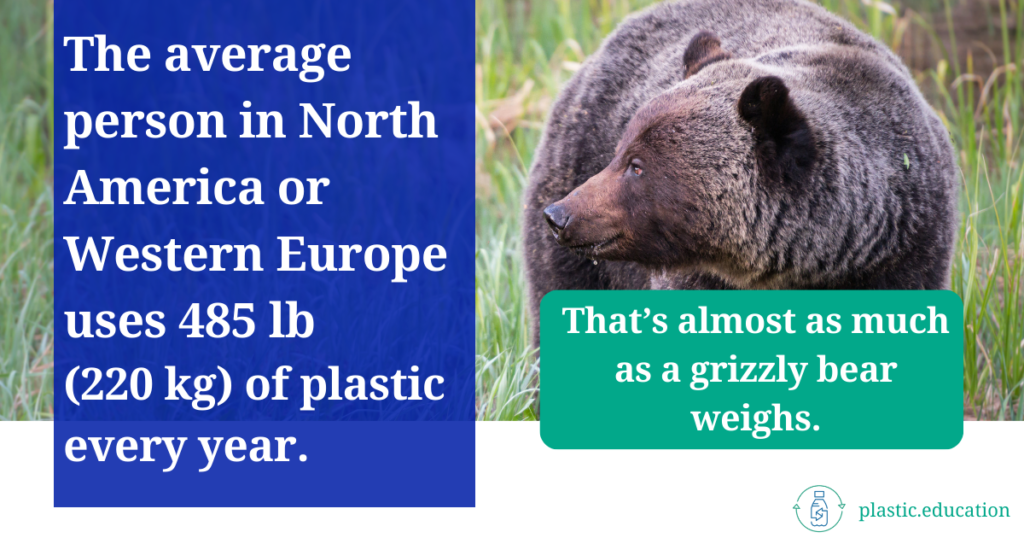Turning off the faucet…
Plastic production has increased twenty-fold over the last 50 years – Over 300 million tons of plastic is being produced every year. And it’s adding up. Eight million metric tons of that enters the ocean each year.
Our dependency on plastics for their convenience and versatility has grown exponentially. And it is projected to grow still. However, without proper facilities to dispose of all this waste, our exceeding consumption of plastics is guaranteed to create irreparable damage to the oceans, the earth, and possibly our own population.
There’s been very little action at the global or state level, though, to resolve this problem. So what can you do about it personally? Well, one way to directly counteract the plastic problem is to stop it from the source by reducing your consumption of plastics.

How do my Individual Actions as a Consumer Help?
By using less plastic, even on the individual level, it means that less plastic is being purchased and used. Less plastic being used means that less plastic needs to be made, and therefore more plastic is being prevented from entering the environment to begin with.
For example, if just one individual starts using a reusable water bottle, an average of 217 plastic water bottles will be saved over the course of one year. Just one individual’s actions have the potential to prevent 217 plastic water bottles from entering landfills and the natural environment.
Not only that, but a reduction in plastic consumption on the individual level has the power to affect the overall demand for plastic products.
All the time, companies are looking to find ways to better cater to consumer needs. One of the most tangible examples of this can be seen in our current food market. The sales growth of organic food has doubled in a matter of four years. Reacting to the demand, more and more food retailers such as Walmart, Costco, and Kroger have made organic food more prevalent and accessible to consumers in their stores.
By choosing not to purchase and use unnecessary plastic items like single-use water bottles, traditional plastic toothbrushes, or say, plastic straws, the demand for such products decreases, which, in turn, decreases production and supply.
As the individual begins to consume less, the manufacture of plastics begins to decrease and there’s potential for massive change on a cultural level.
The less plastic we use in our daily lives, the easier it will be to shift our culture from a single-use frame of mind.
We are already seeing this shift in grocery stores as more and more people are taking action against plastics. Earlier this year, Amsterdam created one of the first plastic-free grocery aisles in direct response to consumers’ demand for less plastic.
How big of a difference will this make though? Can an individual’s actions really add up?
The answer is: Yes.
Just ‘one’ Person
As we go through the day, most people don’t think about exactly how much plastic they consume. It’s just one coffee cup in the morning, one plastic bag of groceries, one night out that required a take-out container. But these things add up, and at the individual level, we consume a lot of plastic.
— The average person in North America or Western Europe consumes 220 kg of plastic per year.
— In the U.S. alone, the average person produces more than 2.5 kg of waste every day.
— Purchasing coffee on the go? One to-go coffee per day creates about 10.5 kg of waste in one year.
— From grocery stores, to clothing stores, to restaurant take-out, plastic bags are used for everything.
— The average person uses 300 single-use plastic bags per year in the U.S.
These numbers add up quickly. But fortunately, that also means that simple changes can make significant changes. So what can you do as an individual to consume less plastic?
Invest in…
A reusable water bottle. By using a reusable water bottle, one individual can save 217 plastic water bottles per year.
A reusable tote. Single use plastic bags have become an overwhelming problem globally. Opt for using a reusable tote at the grocery store or choose paper instead of plastic.
A reusable coffee mug. Reduce the amount of disposable cups you use by simply bringing your own.
Avoid…
Plastic straws. Americans use 500 straws every day. Reduce plastic consumption by merely choosing to drink your beverage without a straw.
Liquid soap. Start using bar soap rather than liquid body soap. Some retailers even carry bar shampoo.
Packaged produce. Retailers have begun selling produce packaged in plastic. Buy whole, fresh produce instead to avoid plastic packaging.
Opt for…
Products sold in alternative packaging. On average, 31 kg of plastic packaging waste is produced per person per year in the EU. Try to buy goods sold in glass or paper packaging or bulk foods filled in your own containers.
How Should I go About Reducing my Consumption of Plastic?
There are so many ways to reduce your consumption of plastic in your daily life. Easier said than done though, right? Where do you start?
1) As famously quoted by folk singer and social activist Pete Seeger, “The first step in solving a problem is recognizing that there is one.” One of the most important steps to reducing your plastic consumption is to be aware of how much you consume.
2) Ditch the plastic you can, whenever you can. We are confronted with unnecessary plastics all the time. Once you start to recognize them, it’s easy to opt out or find a different option.
3) Which brings us to the last – finding alternatives. Invest in alternative options like reusable bottles, cups, and bags. Experiment with eco-alternatives, such as bamboo toothbrushes or bar shampoo.
